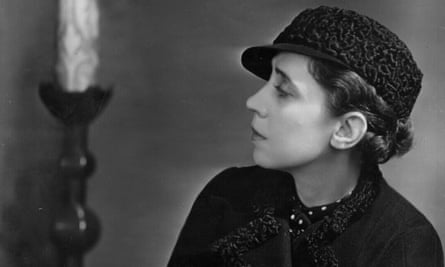Biographers usually have their work cut out when it comes to fashion designers, the principal problem being that the clothes tend to be more reliably thrilling than the career, the sequins and seams a good deal less tedious than the shows and tantrums. But Elsa Schiaparelli is a case apart, for while the designs are certainly beautiful (and frequently batty – it was the Schiap, after all, who created a hat that resembled a lamb cutlet), they’re more than matched by her complex, tumultuous life. Hers is a narrative that requires the biographer, metaphorically speaking, to wear flat shoes rather than stilettos, and to carry not some darling little clutch, but a large and sturdy tote. The cast list is thrilling (Dalí, Cocteau, Man Ray, the Duke and Duchess of Windsor), the locations are glamorous (Paris, Biarritz, New York), and then there is the terrible fissure that was the second world war.
All the same, it isn’t an easy tale to tell. Like her great rival Coco Chanel, Schiaparelli’s story is veiled in mystery, the result of deliberate obfuscation on her part. Omissions and lies abound; some significant figures remain unwilling, for whatever reason, to talk about her (her granddaughter, Marisa Berenson, did not respond to the approaches of Meryle Secrest, her latest biographer). Her career, moreover, comes with a charlatan edge that renders the joining of dots, especially regarding her business, somewhat hazardous. Self-invention can be a fine thing in a designer; if you’ve never learned the rules, what’s to stop you from putting shoes on heads, lobsters on evening dresses, and perfume in Mae West-shaped bottles? But it also makes people shifty: prone to exaggeration, reluctant to look back.

Schiaparelli was born in Rome in 1890, her father an academic whose field was the Islamic world in the middle ages. Convinced from an early age of her ugliness, and determined to dodge her parents’ marriage plans, she made her way first to Paris – becoming an overnight sensation when a ballgown she’d made from four yards of navy crepe de chine and two yards of orange silk fell apart during a particularly lively tango – and then to London where, aged 23, she married Wilhelm de Wendt de Kerlor. A Swiss-born conman of Polish extraction, de Kerlor made his living as a palm-reader, medium and lecturer in the paranormal. Secrest’s book includes two bizarre photographs of Schiaparelli at this time. In the first, she is blindfolded and attempting to communicate with the dead under de Kerlor’s instruction; in the second, she is falling backwards having been hypnotised by him.
The spell, however, didn’t last long. After de Kerlor was deported under the Vagrancy Act for fortune-telling, Schiaparelli followed him to New York, and they had a daughter, Maria Luisa, aka Gogo. But then de Kerlor took the couple’s mink bedspread to a tailor and asked that it be made into the lining of his coat, and something in her snapped.

She returned alone to Paris where, thanks to a friendship with Gaby Buffet-Picabia, ex-wife of the Dadaist artist Francis Picabia, Schiaparelli soon met Cocteau and his circle. Buffet-Picabia was, in fact, extremely useful. She also knew the great designer Paul Poiret, and when he admired a dress Schiaparelli had made for her, the die was cast: the Schiap set herself up as the high priestess of “wearable” fashion. These things are, of course, relative. Her statement gowns and knee-length capes, with their jokes and feathers and fine embroidery, were extremely lavish, and often highly complicated in their construction. But she was also an exponent of such wacky modernities as Rayon, zips, and dresses that did not need to pulled over the head.
Schiaparelli was a neglectful mother and a grumpy, short-tempered friend and colleague. She was also, by Secrest’s telling, a German spy. Her biographer has some evidence for this: Schiaparelli was a friend both of Otto Abetz, Hitler’s ambassador to France, and Gaston Bergery, one of the Vichy regime’s leading lights (Bergery’s wife, Bettina Shaw Jones, was Schiaparelli’s assistant); the designer was able to move with some ease between America and France even when the latter was occupied; the FBI had her under observation.
When the war ended and Schiaparelli returned to France, she was questioned by the authorities but never charged with collaboration. The whiff of it, though, must have stayed on her. Secrest speculates that she may have been ostracised, and perhaps this was one reason she lost her gift; it’s hard to be exuberant when people are whispering, and guilt – if she felt it – can’t have been conducive to the creation of witty frocks. Though she hired a young Hubert de Givenchy as her assistant, her designs grew clumsy. The business closed in 1954. She died in 1973.
As for Secrest, she too has a long career behind her (among her other subjects have been Modigliani and Stephen Sondheim). She isn’t the most elegant writer, being prone to breathlessness and odd rhetorical leaps. But it’s hardly her fault that Schiaparelli is so damnably elusive, and what Secrest lacks in clarity she makes up for in enthusiasm. Her story fairly rips along, and when it all gets too much, you can always take refuge in the clothes, of which there are many lavish photographs. After all, it was into these dreamscapes of silk and velvet that Schiaparelli put the best of herself. They are still without peer: unique, unfathomably flattering, wondrous.

Comments (…)
Sign in or create your Guardian account to join the discussion